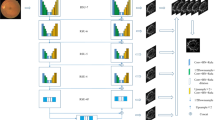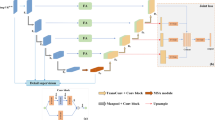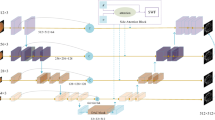Abstract
Automated extraction of cerebrovascular is of great importance in understanding the mechanism, diagnosis, and treatment of many cerebrovascular pathologies. However, segmentation of cerebrovascular networks from magnetic resonance angiography (MRA) imagery continues to be challenging because of relatively poor contrast and inhomogeneous backgrounds, and the anatomical variations, complex geometry and topology of the networks themselves. In this paper, we present a novel cerebrovascular segmentation framework that consists of image enhancement and segmentation phases. We aim to remove redundant features, while retaining edge information in shallow features when combining these with deep features. We first employ a Retinex model, which is able to model noise explicitly to aid removal of imaging noise, as well as reducing redundancy within an image and emphasizing the vessel regions, thereby simplifying the subsequent segmentation problem. Subsequently, a reverse edge attention module is employed to discover edge information by paying particular attention to the regions that are not salient in high-level semantic features. The experimental results show that the proposed framework enables the reverse edge attention network to deliver a reliable cerebrovascular segmentation.
Access this chapter
Tax calculation will be finalised at checkout
Purchases are for personal use only
Similar content being viewed by others
References
Yasugi, M., Hossain, B., Nii, M., Kobashi, S.: Relationship between cerebral aneurysm development and cerebral artery shape. J. Adv. Comput. Intell. Intell. Inform. 22(2), 249–255 (2018)
Fraz, M., et al.: Blood vessel segmentation methodologies in retinal images - a survey. Comput. Methods Programs Biomed. 108(1), 407–433 (2012)
Zhao, Y., Rada, L., Chen, K., Harding, S.P., Zheng, Y.: Automated vessel segmentation using infinite perimeter active contour model with hybrid region information with application to retinal images. IEEE Trans. Med. Imaging 34(9), 1797–1807 (2015)
Zhao, Y., et al.: Automatic 2-D/3-D vessel enhancement in multiple modality images using a weighted symmetry filter. IEEE Trans. Med. Imaging 37(2), 438–450 (2017)
Zhao, Y., et al.: Retinal artery and vein classification via dominant sets clustering-based vascular topology estimation. In: Frangi, A.F., Schnabel, J.A., Davatzikos, C., Alberola-López, C., Fichtinger, G. (eds.) MICCAI 2018. LNCS, vol. 11071, pp. 56–64. Springer, Cham (2018). https://doi.org/10.1007/978-3-030-00934-2_7
Zhao, Y., et al.: Automated tortuosity analysis of nerve fibers in corneal confocalmicroscopy. In: IEEE Transactions on Medical Imaging (2020)
Yang, X., Cheng, K.T., Chien, A.: Geodesic active contours with adaptive configuration for cerebral vessel and aneurysm segmentation. In: 2014 22nd International Conference on Pattern Recognition, pp. 3209–3214. IEEE (2014)
Forkert, N.D., et al.: 3D cerebrovascular segmentation combining fuzzy vessel enhancement and level-sets with anisotropic energy weights. Magn. Reson. Imaging 31(2), 262–271 (2013)
Frangi, A.F., Niessen, W.J., Vincken, K.L., Viergever, M.A.: Multiscale vessel enhancement filtering. In: Wells, W.M., Colchester, A., Delp, S. (eds.) MICCAI 1998. LNCS, vol. 1496, pp. 130–137. Springer, Heidelberg (1998). https://doi.org/10.1007/BFb0056195
Cetin, S., Unal, G.: A higher-order tensor vessel tractography for segmentation of vascular structures. IEEE Trans. Med. Imaging 34(10), 2172–2185 (2015)
Phellan, R., Peixinho, A., Falcão, A., Forkert, N.D.: Vascular segmentation in TOF MRA images of the brain using a deep convolutional neural network. In: Cardoso, M.J., et al. (eds.) LABELS/CVII/STENT -2017. LNCS, vol. 10552, pp. 39–46. Springer, Cham (2017). https://doi.org/10.1007/978-3-319-67534-3_5
Livne, M., et al.: A u-net deep learning framework for high performance vesselsegmentation in patients with cerebrovascular disease. Frontiers Neurosci. 13, 97 (2019)
Ronneberger, O., Fischer, P., Brox, T.: U-Net: convolutional networks for biomedical image segmentation. In: Navab, N., Hornegger, J., Wells, W.M., Frangi, A.F. (eds.) MICCAI 2015. LNCS, vol. 9351, pp. 234–241. Springer, Cham (2015). https://doi.org/10.1007/978-3-319-24574-4_28
Sanchesa, P., Meyer, C., Vigon, V., Naegel, B.: Cerebrovascular network segmentation of mra images with deep learning. In: IEEE 16th International Symposium on Biomedical Imaging (ISBI 2019), pp. 768–771. IEEE (2019)
Zhang, B., et al.: Cerebrovascular segmentation from TOF-MRA using model-and data-driven method via sparse labels. Neurocomputing, (2019)
Land, E.H., McCann, J.J.: Lightness and retinex theory. J. Opt. Soc. Am. 61(1), 1–11 (1971)
Elad, M.: Retinex by two bilateral filters. In: Kimmel, R., Sochen, N.A., Weickert, J. (eds.) Scale-Space 2005. LNCS, vol. 3459, pp. 217–229. Springer, Heidelberg (2005). https://doi.org/10.1007/11408031_19
He, K., Zhang, X., Ren, S., Sun, J.: Deep residual learning for image recognition. In: Proceedings of the IEEE conference on computer vision and pattern recognition, pp. 770–778. IEEE (2016)
Pang, Y., Li, Y., Shen, J., Shao, L.: Towards bridging semantic gap to improve semantic segmentation. In: Proceedings of the IEEE International Conference on Computer Vision, pp. 4230–4239. IEEE (2019)
Chen, S., Tan, X., Wang, B., Hu, X.: Reverse attention for salient object detection. In: Proceedings of the European Conference on Computer Vision (ECCV), pp. 234–250 (2018)
Zhao, H., Shi, J., Qi, X., Wang, X., Jia, J.: Pyramid scene parsing network. In: Proceedings of the IEEE conference on computer vision and pattern recognition, pp. 2881–2890. IEEE (2017)
Aylward, S.R., Bullitt, E.: Initialization, noise, singularities, and scale in height ridge traversal for tubular object centerline extraction. IEEE Trans. Med. Imaging 21(2), 61–75 (2002)
He, K., Sun, J., Tang, X.: Guided image filtering. IEEE Trans. Pattern Anal. Mach. Intell. 35, 1397–1409 (2013)
Çiçek, Ö., Abdulkadir, A., Lienkamp, S.S., Brox, T., Ronneberger, O.: 3D U-Net: learning dense volumetric segmentation from sparse annotation. In: Ourselin, S., Joskowicz, L., Sabuncu, M.R., Unal, G., Wells, W. (eds.) MICCAI 2016. LNCS, vol. 9901, pp. 424–432. Springer, Cham (2016). https://doi.org/10.1007/978-3-319-46723-8_49
Milletari, F., Navab, N., Ahmadi, S.A.: V-net: fully convolutional neural networks for volumetric medical image segmentation. In: 2016 Fourth International Conference on 3D Vision (3DV), pp. 565–571. IEEE (2016)
Acknowledgment
This work was supported by Beijing Natural Science Foundation (4202011), National Natural Science Foundation of China (61572076), Key Research Grant of Academy for Multidisciplinary Studies of CNU (JCKXYJY2019018), Zhejiang Provincial Natural Science Foundation of China (LZ19F010001), and Ningbo “2025 S&T Megaprojects” (2019B10033, 2019B10061).
Author information
Authors and Affiliations
Corresponding authors
Editor information
Editors and Affiliations
Rights and permissions
Copyright information
© 2020 Springer Nature Switzerland AG
About this paper
Cite this paper
Zhang, H. et al. (2020). Cerebrovascular Segmentation in MRA via Reverse Edge Attention Network. In: Martel, A.L., et al. Medical Image Computing and Computer Assisted Intervention – MICCAI 2020. MICCAI 2020. Lecture Notes in Computer Science(), vol 12266. Springer, Cham. https://doi.org/10.1007/978-3-030-59725-2_7
Download citation
DOI: https://doi.org/10.1007/978-3-030-59725-2_7
Published:
Publisher Name: Springer, Cham
Print ISBN: 978-3-030-59724-5
Online ISBN: 978-3-030-59725-2
eBook Packages: Computer ScienceComputer Science (R0)





